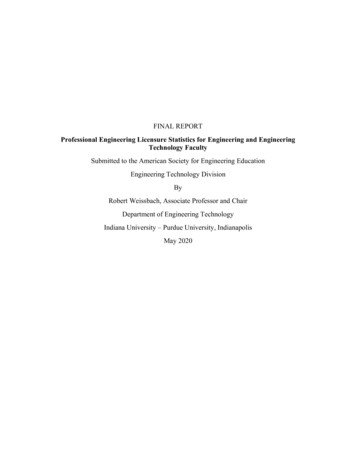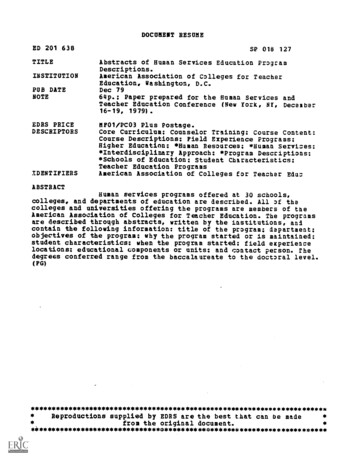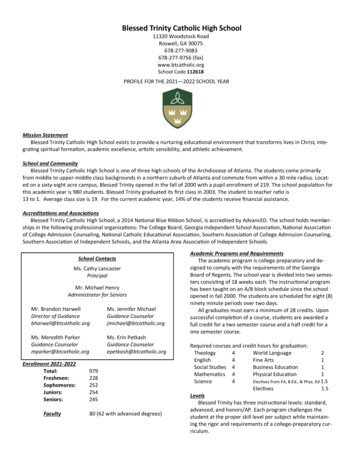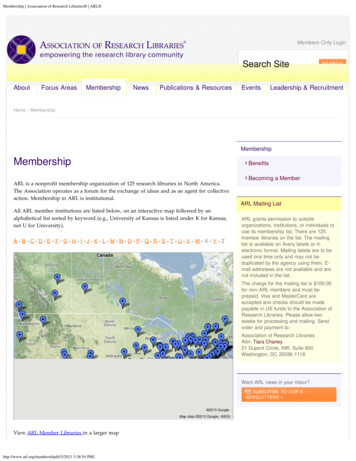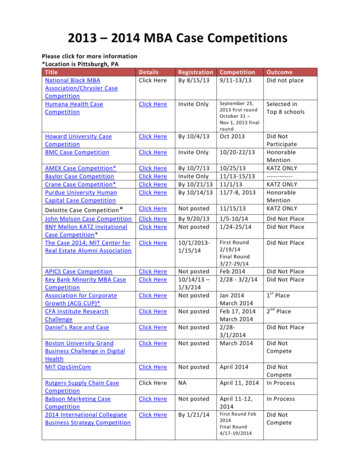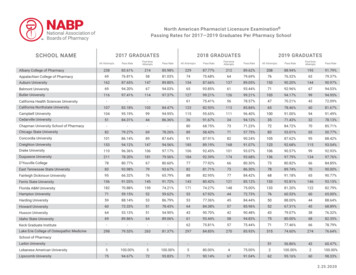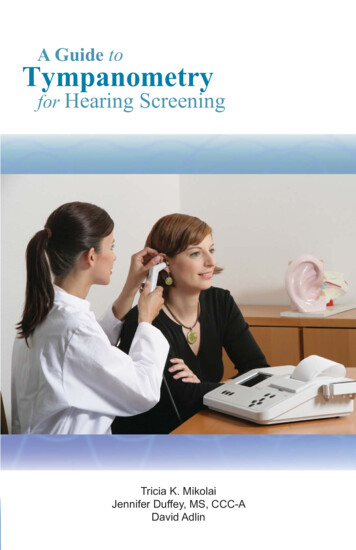
Transcription
A Guide toTympanometryfor Hearing ScreeningTricia K. MikolaiJennifer Duffey, MS, CCC-ADavid Adlin
IntroductionTympanometry is a testing methodology that is used to evaluatethe function of the middle ear. It provides a graphic representationof the relationship of air pressure in the external ear canal toimpedance (resistance to movement) of the ear drum and middleear system.This impedance measurement examines the acoustic resistance ofthe middle ear. If the eardrum is hit by a sound, part of the soundis absorbed and sent via the middle ear to the inner ear while theother part of the sound is reflected.The information derived from tympanometry provides the physician with additional information regarding the patient’s middle earfunction. In a pediatric population this is typically to document orrule out the presence of otitis media, tympanic membrane perforation or Eustachian tube dysfunction. The test is non-invasive anddoes not require any response from the patient. Typical test timefor both ears is less than two minutes.1
How a tympanometer worksThe tympanometer has a hand-held probe that is inserted into theear. Inside the probe are three tubes containing a loudspeaker(figure 1: A), a microphone (figure 1: B) and a pump (figure 1: C).ABCFigure 1The probe is inserted into the ear canal and forms an airtight sealfrom the pressure of the eartip against the canal wall. A tone isdelivered through the loudspeaker while the pressure is changedwithin the sealed canal. Then the microphone measures theamount of sound that is reflected back from the eardrum duringthe pressure sweep. This information is then displayed in graphform – the tympanogram.2
The tympanogramA tympanogram provides several pieces of information including: Compliance of the middle ear system (eardrum movement) Ear canal volume Middle ear pressure(normally equal to atmospheric pressure in healthy ears) A pattern that corresponds to various disordersCompliance of the middle ear systemCompliance is plotted vertically on the tympanogram (figure 2).Figure 2Maximum compliance of the middle ear system occurs when thepressure in the middle ear cavity is equal to the pressure in theexternal auditory canal. The maximum compliance value occurs atthe highest peak of the curve on the graph (figure 3).Figure 33
When you create positive and negative pressure the eardrumstiffens and the compliance decreases. You can then drawconclusions on the condition of the middle ear from the numericalvalue and shape of the tympanogram.Middle ear pressurePressure is plotted horizontally on the tympanogram (circled infigure 4).Figure 4Pressure in the external auditory canal is varied from -200 daPathrough 400 daPa while monitoring impedance. Impedance islowest (maximal compliance) when pressure in the canal equalspressure contained within the middle ear space. Therefore you candetermine the middle ear pressure by locating the value on thehorizontal axis that corresponds to the peak of maximumcompliance on the vertical axis (shown with arrows on figure 4).Ear canal volumeAs a general rule, values for ear canal volume should be between0.2 and 2.0 ml (children and adults). A variance will be seenwithin this range depending on the age and ear structure of theperson. For example, a 2.0 ml or larger reading in a small childcould indicate a perforation in the tympanic membrane or a patentP.E. tube, while it may be a normal reading in an adult.4
A compliance peak within a normative range (see appendix A onpage 13) indicates normal mobility of the middle ear system. Apeak found outside of these limits may indicate one of severalpathologies.Pattern of the curveFigure 5 shows the “Type A” curve of a normal tympanogram.This curve is shown as a thick dark line against the shaded area(shading shows the area a “normal” tympanogram would fall into).Figure 5In a “Type A” curve, the peak compliance occurs at or nearatmospheric pressure indicating normal pressure within themiddle ear.This kind of curve has three subcategories:A: Normal shape reflects a normal middle ear mechanism.AD: A deep curve with a tall peak indicates an abnormallycompliant middle ear system, as typically seen withossicular chain dislocation or loss of elastic fibers in thetympanic membrane.AS: A shallow curve indicative of a stiff system, as seen inotosclerosis or thickened tympanic membrane.5
The second pattern forms a “Type B” curve (figure 6).Figure 6A “Type B” curve has no sharp peak and little or no variation inimpedance over a wide sweep range. This is indicative of noncompressible fluid within the middle ear space (otitis media),tympanic membrane perforation, or debris within the external earcanal (cerumen).With the third pattern, a “Type C” curve (figure 7), peakcompliance is significantly below zero (usually less than -200),indicating negative pressure (sub-atmospheric) within the middleear space. This finding is suggestive of Eustachian tubedysfunction or middle ear fluid.Figure 76
Acoustic reflex measurementsAn acoustic reflex, or contraction of the Stapedial muscle, occursunder normal conditions when a sufficiently intense sound ispresented to the auditory pathway. This contraction of the musclecauses a stiffening of the ossicular chain which changes thecompliance of the middle ear system. As in tympanometry, a probetone is used to measure this change in compliance.When the stimulus presentation and measurement are made in thesame ear by means of the probe, this acoustical reflex is referred toas an ipsilateral acoustic reflex. When the stimulus presentationand measurement are made in opposite ears, the reflex is referredto as a contralateral acoustic reflex.An acoustic reflex measurement is taken after the tympanogram isperformed. For best results, this reflex measurement is automatically conducted at the air pressure value where the compliancepeak occurred during the tympanometric test. Stimulus tones ofvarying intensities at 500, 1000, 2000 or 4000 Hz are presented asshort bursts.If a change in compliance greater than 0.05 ml is detected, a reflexis considered present. Because this is an extremely smallcompliance change, any movement of the probe during the testmay produce an artifact (false response). The test result isrecorded as Pass/No Response and in graphical form.Keys to accurate testing Clear the ear of debris Create an air-tight seal between the probe tip and the ear Make sure the patient is still and does not swallow7
The tympanogram results can be combined with the acousticreflex measurements to obtain an accurate picture of the middleear function.The following illustrate some possible scenarios.Eustachian tube dysfunction in the absence of fluid will show anormal compliance curve, but it will be displayed to the negativeside of the tympanogram. Ear canal volume will be normal and thereflex may be present, depending on the degree of involvement.Other disorders, such as a perforation in the tympanic membrane,will cause a high ear canal volume measurement because theinstrument will measure the volume of the entire middle ear spacein addition to the volume of the ear canal. An extremely flaccidtympanic membrane or an ossicular chain discontinuity will yielda very high peak compliance in the presence of normal middle earpressure. Ear canal volume will be normal and the reflex will beabsent.A fixation of the ossicular chain, as in otosclerosis, will produce atympanogram with very low compliance in the presence of normalmiddle ear air pressure. Ear canal volume is normal and the reflexis absent.Middle ear fluid such as in serious otitis media will yield a veryflat tympanogram with no definite peak and negative air pressure.A resolving case or beginning case may produce a reduced peak inthe presence of severe negative middle ear pressure. The ear canalvolume is normal and the reflex is either absent or at an elevatedlevel.8
How tympanometry fits into your practiceA tympanogram provides documented results of middle earfunction that can assist with the visual otoscopic exam. Animpedance measurement provides a method to diagnose andmonitor disorders that could lead to permanent hearing loss,which is critical especially when working with children.Uses of tympanometry in the clinic: Objective documentation of reduced eardrum movement(i.e., fluid or wax) Monitor chronic middle ear fluid Monitor PE tube function Confirm tympanic membrane perforation Monitor Eustachian tube functionAs a non-invasive test, tympanometry can quickly and easily beperformed on patients of any age, from infants to adults. Testingonly takes about two minutes. The objectivity of tympanometrymeans the results are accurate based on the calculations - they arenot dependent upon a response from the patient.Many tympanometers have the ability to print the test results foreasy filing or to transfer the data to NOAH for database storageand reporting.Advantages of tympanometry Clinical evaluations Objective test method Test patients of any age Documented test results Testing takes about 2 minutes Testing is CPT code reimbursable9
Working with childrenIt is important that patients remain still during the exam. Sometimes children are restless, react sensitively to the change ofpressure or are surprised by the test sound. Take a few moments toprepare the child and child’s parents about the test procedure andinstruct them to stay still.It is sometimes helpful to have the child sit on the parent’s lap andhelp you perform a tympanogram on a stuffed animal to show howthe test works. It can also be beneficial to acclimate the child tobeing touched on the ear. This could be done by playfully touchingthe ear with the probe. If you can touch the ear without problems,the child will normally accept the probe being inserted.Once the child is still, the tympanometer will have stable pressurein the extrenal auditory canal and will activate the test. In addition, when conducting an acoustic reflex test, it is important thatthe child does not speak. Speaking causes the Stapedius muscle tocontract which leads to a change in the compliance of the eardrum.10
CPT reimbursement 1There are two tympanometry tests that are reimbursable usingCurrent Procedural Terminology (CPT) codes.CPT Code 92567: TympanometryCPT Code 92568: Acoustic Reflex Testing; thresholdIn a national survey of Medicare and Medicaid reimbursement,the average reimbursement using CPT code 92567 was 22.00 pertest. In a similar survey, the average reimbursement using CPTcode 92568 was 12.00 per test.In addition to the CPT code, the correct diagnosis code must beutilized. The following diagnosis codes are provided.2380.4 IMPACTED CERUMEN381.0 ACUTE NONSUPPURATIVE OTITIS MEDIA381.02 ACUTE MUCOID OTITIS MEDIA381.03 ACUTE SANGUINOUS OTITIS MEDIA381.04 ACUTE ALLERIGIC SEROUS OTITIS MEDIA381.05 ACUTE ALLERIGIC MUCOID OTITIS MEDIA381.06 ACUTE ALLERIGIC SANGUINOUS OTITIS MEDIA381.81 DYSFUNCTION OF EUSTACHIAM TUBE382.01 ACUTE SUPPURATIVE OTITIS MEDIA WITHSPONTANEOUS RUPTURE OF EARDRUM385.23 DISCONTINUITY OR DISLOCATION OF EAR OSSICLES384.20 PERFORATION OF TYMPANIC MEMBRANEUNSPECIFIED384.21 CENTRAL PERFORATION OF TYMPANIC MEMBRANE384.22 ATTIC PERFORATION OF TYMPANIC MEMBRANE384.23 PERFORATION, MARGINAL, OTHER384.24 PERFORATION, MULTIPLECurrent Procedural Terminology, CPT 2006, Standard Edition,American Medical Association, AMA Press, ISBN: 1-57947-697-X.1International Classification of Diseases, 9th Revision, ClinicalModification, ICD-9-CM 2006, Volumes 1 and 2, American MedicalAssociation, AMA Press. ISBN: 1-57947-692-9 (SPIRAL).211
384.25 PERFORATION, TOTAL387.0 OTOSCLEROSIS, INVOLVING OVAL WINDOW,NONOBLITERATIVE387.10 OTOSCLEROSIS INVOLVING OVAL WINDOWOBLITERATIVE387.9 OTOSCLEROSIS, UNSPECIFIED388.01 PRESBYACUSIS388.02 TRANSIENT ISCHEMIC DEAFNESS388.10 NOISE EFFECTS ON INNER EAR, UNSPECIFIED388.11 ACOUSTIC TRAUMA (EXPOSIVE) TO EAR388.12 NOISE-INDUCED HEARING LOSS388.2 SUDDEN HEARING LOSS, UNSPECIFIED388.30 TINNITUS, UNSPECIFIED388.31 SUBJECTIVE TINNITUS388.32 OBJECTIVE TINNITUS388.40 ABNORMAL AUDITORY PERCEPTION, UNSPECIFIED388.41 DIPLACUSIS388.42 HYPERACUSIS388.43 IMPAIRMENT OF AUDITORY DISCRIMINATION388.44 RECRUITMENT388.50 DISORDERS OF ACOUSTIC NERVE389.0 CONDUCTIVE HEARING LOSS, UNSPECIFIED389.01 CONDUCTIVE HEARING LOSS, EXTERNAL389.02 CONDUCTIVE HEARING LOSS, TYMPANIC389.03 CONDUCTIVE HEARING LOSS, MIDDLE EAR389.04 CONDUCTIVE HEARING LOSS, INNER EAR389.08 CONDUCTIVE HEARING LOSS, COMBINED389.10 SENSORINEURAL HEARING LOSS, UNSPECIFIED389.11 SENSORY HEARING LOSS389.12 NEURAL HEARING LOSS389.14 CENTRAL HEARING LOSS389.18 SENSORINEURAL HEAIRNG LOSS OF COMBINED TYPES389.2 MIXED CONDUCTIVE AND SENSORINEURAL HEARINGLOSS389.7 DEAF MUTISM, NOT ELSEWHERE CLASSIFIABLE389.8 OTHER SPECIFIED FORMS OF HEARING LOSS389.9 UNSPECIFIED HEARING LOSS12
Maico tympanometersMaico Diagnostics offers a variety of tympanometers that can meetthe needs professionals in any testing situation.Testing childrenWhile tympanometry generally takes less than two minutes, thedifficulty with children is getting them to stay still during the test.Maico’s Race Car Tympanometer provides a built-invisual distraction that captures and keeps yourpatient’s attention throughout the test. Onceyou have a complete seal in the ear canal, arace will take place on the unit’s large LCD screenfor your patient to watch. You can then review theresults or print them in seconds.Daily testingTo perform typical daily testing, the MI 24automatic tympanometer provides pass/failresults and ipsilateral reflex testing. Alsoincluded is the convenience of an internal thermal printer.Tympanometry-audiometry testing in one unitThe MI 26 performs the same tympanometrictesting as the MI 24 but has the addedconvenience of air conduction audiometryin the same unit. This is a great way to savetime and office space.The Race Car Tympanometer is also available as a combo unitfeaturing tympanometry and air conduction audiometry.High frequency testingA high frequency probe tone of 1000 Hz can be added to the MI 24as an option. This provides a high frequency test that is ideal foraccurate results when testing neonates up to six months old.13
ConclusionThe ability to objectively measure and document middle earfunction is vital for health care professionals. Most will find thatincorporating tympanometry into their office protocol will notonly provide a level of diagnostic objectivity that was not previously available but will also pay for itself in 3 to 6 months andgenerate additional revenue.Tympanometry offers a fast, non-invasive, and cost effectivemethod to assess the integrity of the middle ear and will ensurethat the middle ear function of a particular patient has been fullyevaluated.14
Appendix A - Normative DataNormative data 3Children (age 3 – 5 years)Mean90% rangePeak Compliance(mmho or cc)Ear Canal Volume(cc)0.50.70.2 to 0.90.4 to 1.0Peak Compliance(mmho or cc)Ear Canal Volume(cc)0.81.10.3 to 1.40.6 to 1.5AdultsMean90% rangePressure typically considered normal in the range of -150 to 25daPa.A compliance peak within a normative range indicates normalmobility of the middle ear system. A peak found outside ofthese limits may indicate one of several pathologies.3Data from Margolis and Heller (1987)15
MAICO DIAGNOSTICS 7625 Golden Triangle Drive, Eden Prairie, MN 55344phone 952-941-4200 toll free 888-941-4201 fax 952-903-4100 www.maico-diagnostics.com
Modification, ICD-9-CM 2006, Volumes 1 and 2, American Medical Association, AMA Press. ISBN: 1-57947-692-9 (SPIRAL). 1 1 2 2. 12 384.25 PERFORATION, TOTAL 387.0 OTOSCLEROSIS, INVOLVING OVAL WINDOW, NONOBLITERATIVE 387.10 OTOSCLEROSIS INVOLVING OVAL WINDOW OBLITERATIVE

